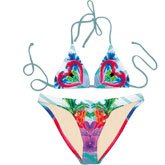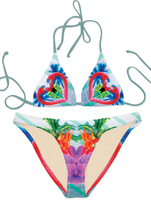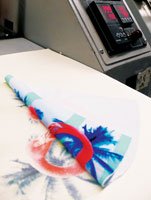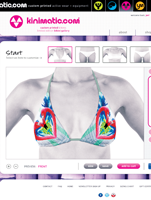TECHNOLOGY
Anymatic Expands Its Made-to-Order Printing Technology
Anymatic founder William Cawley knew it was possible to simply transfer an image onto a piece of fabric through sublimation printing and then cut that fabric to make a pair of boardshorts. The trick that took him years to develop was how to put that power in the consumer’s hands.
Cawley finally achieved that in his Shortomatic customizer technology platform, which launched in 2010. Through a user-friendly website, anyone can upload a photo of his or her choice, rotate the orientation, see a simulation of how the print will appear on a pair of boardshorts and order the garment to be made. This May, Cawley will launch Kinimatic, which implements the same idea of custom printing onto an ambitious number of bikini styles: a nylon/spandex triangle bikini top, bandeau bikini top, tie-side bottom, hipster bottom, polyester microfiber super suede microshorts and a polyester chiffon sarong.
“First and foremost we are a technology company that facilitates this ability to customize,” Cawley said. With the technology in place, it can be altered and applied to any type of garment pattern, he said. Once the information about the orientation of the print and sizing is uploaded into the customizer, Cawley said, “it’s fully automated. The information the printer sees is completely ready to go [for production]. That’s the clever bit.”
A firing start
As a yoga enthusiast with an eye for art and design—previously, Cawley ran his own design agency in London for 15 years—Cawley’s first product under the Santa Monica, Calif.–based Anymatic’s umbrella was Yogamatic. The site allows users to upload and print photographs onto a yoga mat, travel mat and/or yoga towel. It was a long trial-and-error process, experimenting with many different digital printers on closed cell-foam yoga mats.
“They were setting on fire, literally,” Cawley said of early beta test runs.
When it came to garment printing, Cawley tested nearly a dozen printers before being satisfied with “the best dye-sublimation factory” partner for Shortomatic, Kinimatic and the forthcoming Shirtomatic.
“With the price of dye-sublimation printers becoming more affordable, there are many more people producing fabrics, and, in turn, the pricing has become like a commodity. However, where our brands are concerned, there is absolutely no substitute for the using highest-quality, most experienced and reliable services available. Whether it be the constant R&D or the critical production cycle, we are lucky to be partners with our bicoastal print operation,” Cawley said.
Custom customers
Custom design has been a hallmark of Vans shoes since its early years. Russ Pope, Vans Apparel marketing manager, said customers used to bring in their own fabric, which would be used to make a special pair of made-to-order shoes. The customizable-shoe option is still available online, though customers no longer provide the fabric. Instead, they select from a number of color and print choices and can choose which pattern goes on which part of the shoe.
“Vans’ The Era Custom Powered by Shortomatic” uses Anymatic’s technology to translate the custom-shoe legacy into trunks. Fans can design a pair of trunks in exclusive prints and colors, which are updated three times per year. It was important to Vans that there were an extensive number of options to choose from—base color, pattern, second color, print. Each of those steps must be done for the right and left leg, right and left yoke, and pocket.
Brands such as Quiksilver and Hurley also offer custom boardshorts on their site. In both cases, customers can choose which print corresponds to the pattern piece, but they cannot alter the print itself.
“There is a whole slew of more options of things that you can do,” said Vans’ Powered by Shortomatic’s Pope. “The experience as well, on [competitor’s sites], I don’t feel is as rich as ours when you are actually in the process of designing.”
Cawley said that the “critical difference” is that every Anymatic product is printed to order. “Shortomatic and Vans boardshorts are 100 percent user-designed and printed as ‘one-offs’ rather than being sewn together from a range of pre-printed generic prints and patterns.”
Cawley has no plans to wholesale product that is created using the Shortomatic, Kinimatic and Shirtomatic programs. “The heart and soul [are] the customers,” who upload their original artwork, Cawley said. However, he feels there is opportunity to be a resource for designers and companies. The Anymatic user-friendly customization technology can be tweaked so that a designer can realize his or her own ideas and pump it out on higher-quantity production scale.
“Typically, companies/designers want to add a swim silhouette to their collection,” Cawley said. “They generally have concept in mind but need help harnessing the practical and performance-related issues of creating the garment pattern. Secondly, the sourcing of fabric and trim components always requires knowledge based on style and price. Finally, the garment needs to be sampled and priced for final production. We offer these services A to Z.”
Kinimatic prices range from $49 for the 20-by-57-inch sarong to $75 for the micro short. Shortomatic shorts for men and women retail for $99. For more information, visit www.kinimatic.com.

























